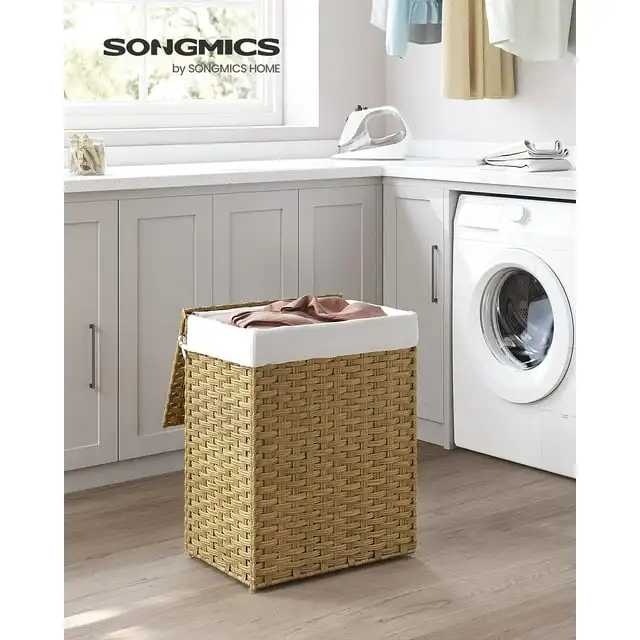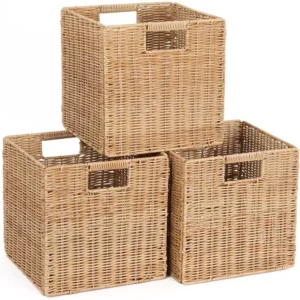Why Choose Wicker Baskets for Laundry Organization
When it comes to organizing your laundry, the containers you choose matter just as much as your sorting system. Wicker baskets stand out as an exceptional choice that bridges the gap between practical storage and beautiful home décor. Unlike plastic bins that clash with your carefully curated interior or fabric hampers that collapse under weight, wicker baskets offer a perfect blend of strength, style, and function.
What sets wicker baskets apart is their natural construction that allows air to circulate freely through the weave. This ventilation is crucial for both dirty and clean laundry. For soiled clothes, it prevents the musty odors and mildew that can develop in airtight containers. For clean laundry awaiting folding, it maintains freshness without trapping moisture or detergent scents.
The benefits of choosing wicker for laundry organization include:
- Natural ventilation that reduces odors and prevents mildew growth
- Visual warmth that elevates utilitarian spaces with organic texture
- Durability that withstands daily use while maintaining its shape
- Versatility that complements any interior design style
- Sustainability that offers an eco-friendly alternative to plastic options
Many homeowners discover that wicker baskets provide excellent laundry storage solutions that outperform synthetic alternatives in both function and appearance. The natural materials bring a touch of nature indoors, creating a more inviting laundry space that feels less like a chore zone and more like an extension of your home’s thoughtful design.
With various sizes, shapes, and weaving patterns available in our wicker laundry basket collection, there’s a perfect option for every space and need. The right selection can transform your laundry routine from mundane to manageable while enhancing your home’s aesthetic appeal.
The Perfect Blend of Form and Function
Wicker laundry baskets transcend mere utility, becoming statement pieces that enhance your home’s character. Unlike plastic bins that require hiding, quality wicker baskets deserve to be displayed. Their natural texture creates visual interest through the interplay of light and shadow across the woven surface.
The beauty of wicker lies in its chameleon-like ability to complement any interior style. In modern spaces, clean-lined wicker baskets with simple weaves provide subtle texture without overwhelming minimalist design. In farmhouse or coastal interiors, chunky weaves and natural finishes enhance the rustic, relaxed atmosphere. Even luxury spaces benefit from high-end wicker with tight, intricate weaving patterns that signal craftsmanship and attention to detail.
Decorative wicker baskets designed for laundry organization often feature special touches like leather handles, decorative bindings, or two-tone weaves that elevate them beyond basic storage. These thoughtful details transform functional items into design elements worthy of display in bedrooms, bathrooms, and living areas.
When strategically placed, these baskets create harmony between practicality and aesthetics, making spaces feel both organized and inviting. The natural materials bring warmth to sterile environments like bathrooms and laundry rooms, creating visual balance against hard surfaces like tile and porcelain.
Practical Benefits Beyond Beauty
While the aesthetic appeal of wicker baskets is immediately apparent, their functional advantages make them truly superior for laundry organization:
• Superior breathability: The natural gaps between woven strands allow continuous airflow that helps damp towels dry and prevents musty odors in dirty clothes.
• Lightweight durability: A medium-sized wicker basket typically weighs 30-50% less than a comparable plastic hamper while offering similar strength.
• Environmentally friendly: Natural wicker materials are biodegradable and renewable, with a significantly lower carbon footprint than plastic alternatives.
• Ergonomic design: Many wicker baskets feature comfortable handles that distribute weight evenly, making laundry transport easier on your hands and back.
The breathability factor proves particularly important in bathrooms and bedrooms where damp items might otherwise create mildew issues. This ventilation helps maintain freshness even when laundry must wait several days between washes.
Another significant advantage is noise reduction—wicker baskets operate silently compared to plastic bins that create disruptive sounds when moved across floors. This quality makes them ideal for bedrooms and shared living spaces where quiet is valued.
These practical benefits explain why wicker baskets provide elegant solutions to laundry clutter in both small apartments and spacious homes. Their combination of function and beauty ensures they earn their keep while enhancing your living environment.
Understanding Wicker Materials and Construction
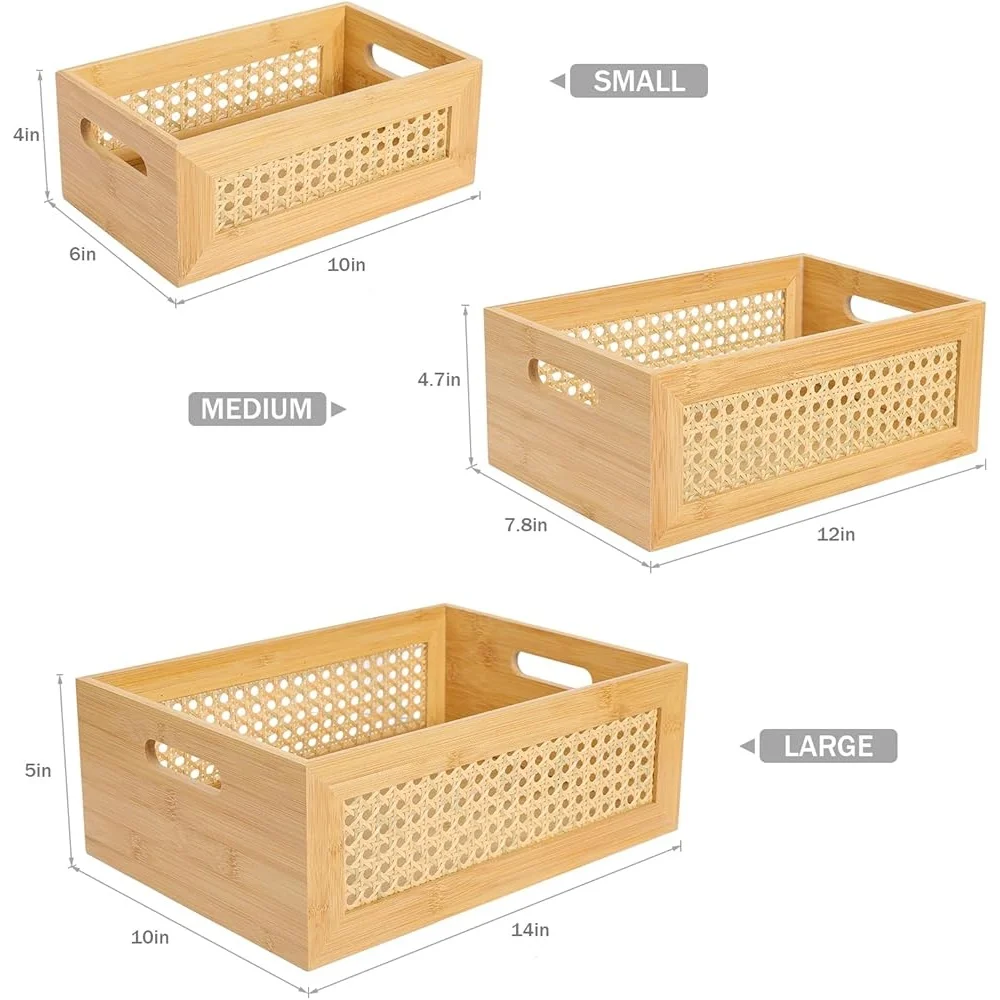
Many people mistakenly believe wicker refers to a specific material, but it actually describes the weaving technique used to create baskets and furniture. This ancient craft dates back thousands of years and appears in cultures worldwide, from Egyptian burial items to Victorian parlor furniture. Understanding the distinction between wicker as a technique and the materials used in wicker construction helps you make informed choices for your laundry organization needs.
The choice of material significantly impacts a wicker basket’s appearance, durability, weight, and suitability for different environments. Natural materials bring unique characteristics and textures, while synthetic alternatives offer practical benefits for certain applications. Knowing these differences helps ensure you select baskets that will perform well in your specific laundry spaces.
The sustainability aspect of wicker materials varies considerably. Natural fibers like rattan, seagrass, and bamboo are renewable resources that grow quickly and require minimal processing. This makes them environmentally friendly alternatives to petroleum-based plastic containers that can take centuries to decompose. By choosing natural wicker versus synthetic materials, you’re often making an eco-conscious decision that reduces environmental impact while bringing natural beauty into your home.
Natural Wicker Materials Explained
Each natural wicker material brings distinct properties that affect its suitability for laundry organization:
Rattan: Derived from palm vines, rattan creates exceptionally sturdy baskets with beautiful grain patterns.
– Highest tensile strength among natural wicker materials
– Excellent durability with proper care (10+ year lifespan)
– Natural golden-brown color that darkens beautifully with age
– Best for high-use areas requiring maximum strength
Our rattan basket collection showcases the versatility and durability of this premium material.
Bamboo: Fast-growing and sustainable, bamboo creates lightweight yet strong baskets.
– Exceptionally renewable (grows up to 3 feet daily)
– Naturally antibacterial properties
– Light weight makes it ideal for transportable laundry baskets
– Best for areas with moderate humidity levels
Water Hyacinth: This invasive aquatic plant creates distinctive, textural baskets.
– Unique bulky appearance with thick, rope-like weaving
– Naturally water-resistant from its aquatic origins
– Rich texture adds visual interest
– Best for statement pieces and decorative laundry storage
Seagrass: This marine plant creates baskets with beautiful natural variations.
– Natural tan color with subtle green undertones
– Excellent tensile strength when dry
– Pleasant natural scent
– Best for dry environments away from direct moisture
Willow: Traditional basket-making material creates rustic, country-style pieces.
– Extremely flexible when soaked, creating tight weaves
– Classic appearance with traditional appeal
– Very lightweight even in larger basket sizes
– Best for decorative laundry storage in low-humidity areas
Each material carries its own sustainability profile, with bamboo and water hyacinth being particularly environmentally friendly due to their rapid growth cycles and minimal processing requirements.
Synthetic Wicker: Pros and Considerations
Synthetic wicker (often called resin wicker or all-weather wicker) uses man-made materials like polyethylene, nylon, or vinyl to mimic the appearance of natural fibers while adding practical benefits:
Pros of Synthetic Wicker:
– Completely waterproof and washable
– Highly resistant to mold and mildew
– Maintains color without fading
– Typically lasts 2-3 times longer than natural materials
– Requires virtually no maintenance
Considerations:
– Lacks the natural warmth and texture variations of genuine materials
– Petroleum-based production raises environmental concerns
– Can become brittle in extremely cold environments
– May not develop the beautiful patina that natural wicker acquires with age
Synthetic options work particularly well in bathrooms, outdoor laundry areas, or spaces with high humidity where natural fibers might deteriorate more quickly. They can be fully submerged for cleaning without damage, making them practical for families with young children or in situations where baskets might be exposed to spills.
The environmental impact of synthetic wicker is worth considering. While its longevity means fewer replacements over time, most synthetic materials aren’t biodegradable and contribute to plastic waste. However, some manufacturers now offer recycled plastic wicker options that provide a more sustainable alternative while maintaining the practical benefits.
Essential Features to Look for in Laundry Wicker Baskets
Selecting the right wicker basket for laundry organization requires attention to key features that enhance functionality. The perfect basket combines appropriate size, thoughtful design elements, and construction quality to create a storage solution that serves your needs beautifully.
When evaluating options, prioritize these essential characteristics:
• Sturdy construction with tight, consistent weaving patterns
• Reinforced rims and corners to prevent unraveling over time
• Quality handles that distribute weight evenly when carried
• Appropriate depth for your typical laundry volume
• Compatible dimensions for your available space
• Functional features like lids, dividers, or liners as needed
Investing in quality initially often proves more economical than replacing inferior baskets that fail quickly. Examine weaving tightness, handle attachment methods, and overall stability before purchasing. A well-made wicker basket should feel solid with minimal flexibility when lifted by the handles.
Households with multiple members benefit from top-rated wicker baskets designed for sorting laundry that include compartments or coordinating sets for separating whites, colors, and delicates. These systems streamline laundry day by allowing pre-sorting throughout the week.
For those concerned about maintaining privacy or containing odors, wicker laundry baskets with lids provide elegant solutions that conceal contents while allowing necessary airflow through the sides.
Size, Shape, and Capacity Considerations
Matching basket dimensions to your household needs prevents both overflow problems and wasted space. Consider these guidelines when selecting the appropriate size:
For single-person households:
– Small baskets (1-2 cubic feet capacity)
– Holds approximately 1-2 loads of laundry
– Ideal for apartments or limited spaces
For couples:
– Medium baskets (2-3 cubic feet capacity)
– Holds approximately 2-3 loads of laundry
– Balances capacity with portability
For families:
– Large wicker laundry baskets (3+ cubic feet capacity)
– Holds 3+ loads of laundry
– May require divided sections for effective sorting
Beyond size, shape significantly impacts functionality. Rectangular baskets maximize floor space efficiency against walls, while round baskets often provide better ergonomics for carrying. Corner-shaped designs utilize otherwise wasted space in bathrooms and bedrooms. Tall, narrow hampers work well in tight spaces between furniture pieces, while wide, shallow baskets make finding specific items easier.
When measuring space for your basket, allow at least 2-3 inches of clearance around the perimeter for air circulation and easy access. Remember that baskets with lids require additional vertical clearance for opening, typically 6-12 inches depending on design.
Functionality Enhancers: Lids, Liners, and Handles
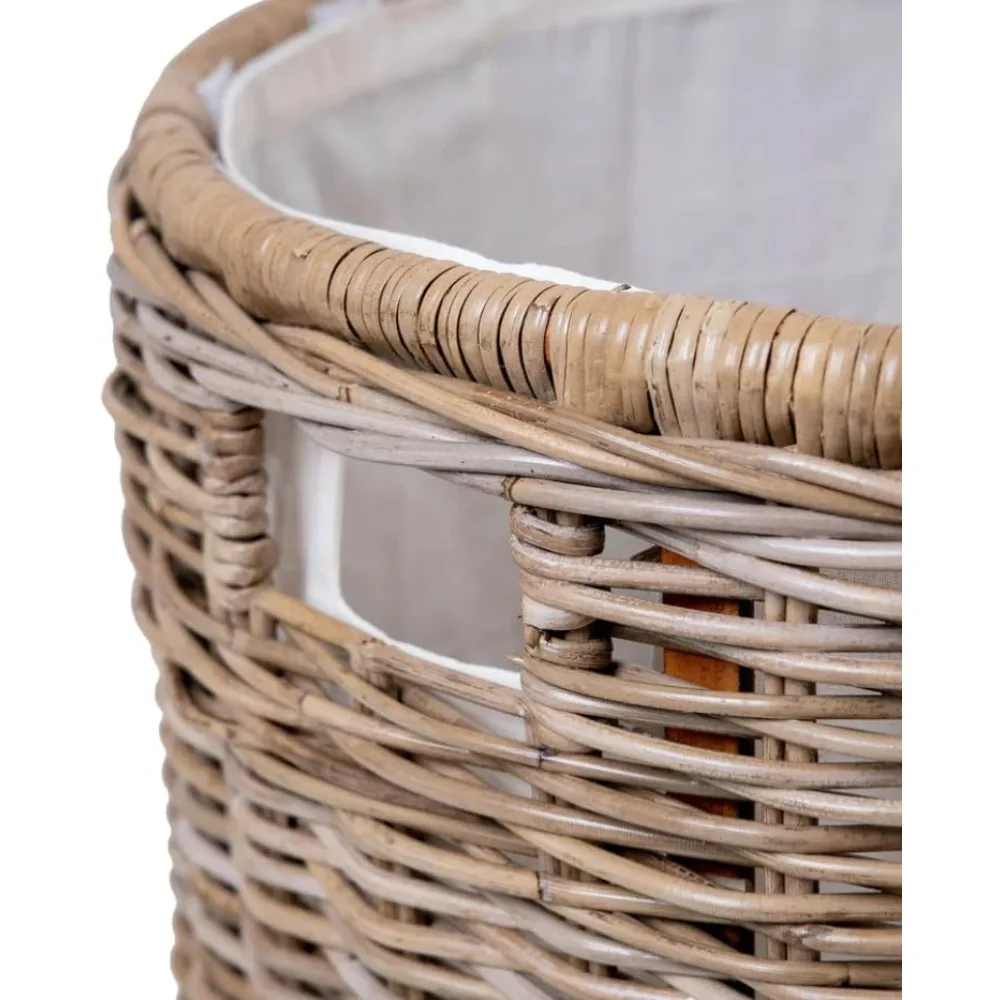
Certain features significantly enhance the functionality of wicker laundry baskets in specific situations:
Lids provide multiple benefits that justify their popularity:
– Conceal laundry from view for greater privacy and tidiness
– Contain odors from soiled gym clothes or baby items
– Create flat surfaces for temporary storage or folding
– Add a finished appearance that elevates the basket’s aesthetic value
The transformative benefits of lidded laundry hampers make them particularly valuable in bedrooms and multi-purpose spaces where appearance matters. Look for lid designs that balance ventilation with concealment—hinged lids offer the most convenient access, while removable lids may provide better airflow.
Liners protect both your laundry and the basket:
– Create barriers between damp items and wicker material
– Prevent snags on delicate fabrics
– Simplify emptying and cleaning
– Extend basket lifespan by reducing wear
Removable, washable cotton liners offer the best combination of breathability and practicality. Avoid plastic or waterproof liners in most situations, as they prevent the beneficial airflow that makes wicker advantageous for laundry storage.
Handles determine comfort and carrying capacity:
– Cutout handles work well for lightweight baskets but can be uncomfortable with heavy loads
– Rope handles distribute weight evenly but may wear over time
– Leather handles offer premium comfort but require occasional conditioning
– Reinforced side handles provide maximum strength for heavy loads
Handle placement should align with your typical carrying position—side handles work best for hip-carrying, while handles that meet in the center facilitate one-handed carrying. Test the comfort of handles before purchasing whenever possible.
Creating Effective Laundry Organization Systems
Transforming laundry from a dreaded chore to a manageable task often comes down to implementing thoughtful organizational systems. Wicker baskets provide both the functionality and flexibility needed to create customized solutions for any household routine.
Effective laundry systems address the entire process from collection to folding. Start by evaluating your current pain points—whether it’s family members mixing colors with whites, clean clothes piling up unfolded, or inefficient workflows between washing, drying, and storing. Then design a system using appropriately sized and strategically placed wicker baskets to address these specific challenges.
Creating effortless laundry organization with wicker baskets typically involves:
- Establishing consistent collection points in bedrooms and bathrooms
- Implementing clear sorting systems using multiple baskets
- Creating designated spaces for in-process laundry
- Designing efficient folding and distribution stations
- Maintaining the system through regular resets and adjustments
The visual appeal of wicker baskets encourages family compliance with organizational systems. Unlike utilitarian plastic bins that signal “chore,” attractive wicker pieces feel more like intentional home décor, increasing the likelihood that family members will maintain the system.
Streamlined Sorting Systems
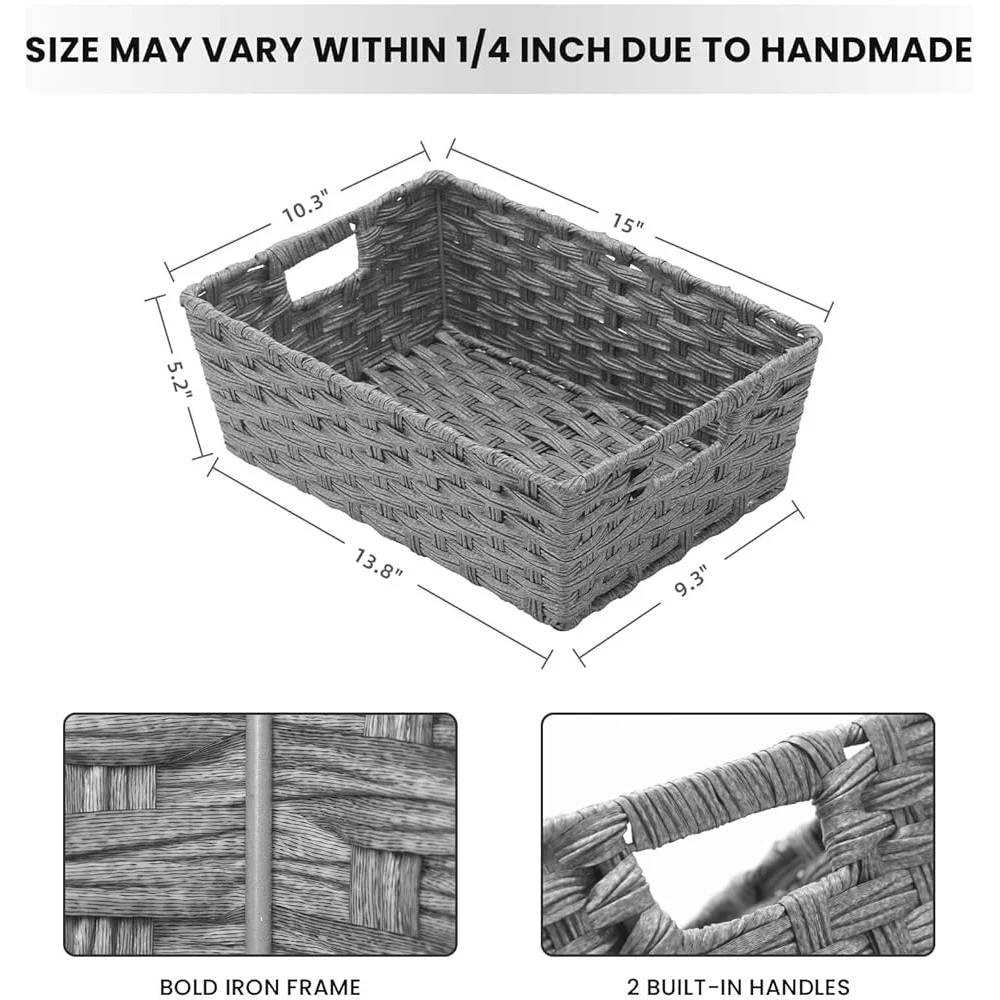
Effective sorting forms the foundation of efficient laundry management. Using multiple wicker baskets creates visual and physical separation between different laundry categories, preventing costly mistakes like color transfers or fabric damage.
Common sorting approaches include:
Color-based sorting:
– Light/white items
– Dark/black items
– Colorful/printed items
Wash-type sorting:
– Regular cycle items
– Delicate/handwash items
– Heavy-duty/towels/bedding
Person-specific sorting:
– Individual baskets for each family member
– Shared categories for household linens
Implementing creative laundry basket organization hacks can maximize efficiency while minimizing space requirements. Try these proven strategies:
- Stack sorting baskets vertically with the most frequently used on top
- Label baskets clearly with fabric tags or wooden signs
- Position baskets at the point of undressing for immediate sorting
- Use different basket shapes for different laundry categories to create visual cues
- Implement a “pre-treating” basket for stained items requiring attention
For families, assigning distinctive basket styles to each person creates ownership of the process. Children as young as three can learn to place dirty clothes in their designated basket, establishing helpful habits early while reducing parental workload.
The psychology behind visible sorting systems proves particularly effective—when we can see our categories clearly defined, we’re more likely to maintain them consistently. This visual organization reduces decision fatigue and increases system compliance.
Maximizing Laundry Room Efficiency
Even the most compact laundry area can function efficiently with strategic basket placement. Create distinct zones for different stages of the laundry process using appropriately sized wicker containers:
Pre-wash zone:
– Sorting baskets for different load types
– Small container for lost socks awaiting matches
– Shallow basket for items requiring pre-treatment
In-process zone:
– Medium basket for items removed from dryer awaiting folding
– Small containers for dryer sheets, pods, and other supplies
– Hanging space or basket for air-dry items
Post-wash zone:
– Folding surface (top of washer/dryer or dedicated table)
– Distribution baskets for returning items to appropriate rooms
– Storage for ironing supplies
For comprehensive solutions to laundry organization challenges, explore our complete laundry solutions collection featuring coordinated pieces designed to work together.
Vertical storage proves particularly valuable in space-challenged laundry areas. Stack compatible baskets on shelving units, use wall-mounted basket systems, or select tall, narrow hampers that maximize capacity while minimizing footprint. In humid laundry environments, ensure adequate airflow around all baskets to prevent moisture accumulation.
Our customers find that transforming their laundry space with premium storage baskets creates a more inviting environment that makes necessary tasks feel less burdensome. The aesthetic improvement often inspires better maintenance of organizational systems, creating a positive cycle of efficiency.
Integrating Wicker Baskets Throughout Your Home
Effective laundry management extends beyond the laundry room. Strategic placement of wicker baskets throughout your home creates a comprehensive system that minimizes effort while maximizing organization.
The most successful laundry management systems incorporate collection points where clothes naturally come off—bedrooms, bathrooms, and closets. By positioning attractive wicker baskets in these locations, you create convenient disposal points that prevent piles of clothes on floors or furniture.
Consider these placement strategies for whole-home laundry management:
- Master bedroom: Large hamper with sorting capability
- Children’s rooms: Individual hampers sized appropriately for their laundry volume
- Guest room: Small, decorative hamper for occasional use
- Master bathroom: Medium hamper with lid for damp towels
- Family bathroom: Larger hamper with ventilation for multiple users
- Mudroom/entryway: Small basket for soiled outdoor items
For space-efficient solutions that work in any room, explore our wicker laundry basket storage ideas featuring creative placement options for homes of all sizes.
The beauty of using wicker throughout your home lies in its design versatility. Unlike plastic utility baskets that create visual discord when placed in living spaces, wicker pieces maintain design cohesion across different rooms. Choose similar weaving patterns or complementary tones to create visual flow between spaces.
Strategic Placement for Maximum Efficiency
Thoughtful basket placement significantly reduces the effort required for laundry management. The key principle is minimizing the number of steps between where clothes are removed and where they’re collected.
For bedrooms, place hampers:
– Near closets where clothes are changed
– In walk-in closets for immediate disposal
– Adjacent to the bathroom for convenient access
– In corners that optimize floor space
For bathrooms, select wicker hampers with lids that:
– Fit between fixtures without impeding movement
– Provide ventilation while containing moisture
– Maintain the aesthetic quality of the space
– Offer easy access during routines
In family settings, consider these strategic approaches:
– Position children’s hampers where they can easily reach them
– Place shared hampers in central hallways between bedrooms
– Create “drop stations” near entryways for sports uniforms or work clothes
– Establish clear paths for transporting full baskets to the laundry area
Behavioral psychologists note that systems requiring minimal effort see significantly higher compliance rates. When baskets are positioned within arm’s reach of where clothes are removed, proper disposal becomes the path of least resistance, increasing the likelihood of maintaining organization.
Common placement mistakes include positioning baskets in closets with doors (creating barriers to use) and selecting locations that require bending or reaching, which discourages regular use. The most effective placements make proper disposal easier than improper alternatives.
Proper Care and Maintenance of Wicker Laundry Baskets

With proper care, quality wicker laundry baskets can provide years of beautiful service. Understanding the appropriate maintenance techniques for different materials ensures your organizational investment retains both functionality and appearance over time.
Regular maintenance prevents most common issues and extends basket lifespan significantly. Implement these simple practices in your routine:
- Dust baskets weekly with a soft brush or vacuum with brush attachment
- Inspect handles and rims monthly for signs of loosening or wear
- Keep baskets away from direct sunlight to prevent fading and brittleness
- Rotate baskets periodically for even wear if they receive direct sunlight
- Address minor damage immediately before it spreads
Seasonal deep cleaning helps maintain basket appearance and structural integrity. Schedule more thorough cleaning 2-4 times yearly, adjusting frequency based on use and environment. Our guide to proper basket care and maintenance provides detailed instructions for preserving your wicker investments.
Remember that different wicker materials have unique care requirements. Natural fibers generally require more careful moisture management, while synthetic wicker tolerates more aggressive cleaning methods. Always verify the specific material of your basket before applying any cleaning solution or technique.
Cleaning and Moisture Management
Effective cleaning maintains both the appearance and integrity of wicker baskets while preventing odor development. Follow these material-specific guidelines:
For natural wicker cleaning:
1. Begin with dry brushing to remove dust and debris
2. Mix mild soap with warm water (never hot)
3. Lightly dampen—don’t soak—a soft cloth with the solution
4. Gently wipe surfaces, following the direction of the weave
5. Use a toothbrush for tight spaces and corners
6. Allow to air dry completely away from direct heat
7. Apply a small amount of lemon oil every 6-12 months to maintain suppleness
For synthetic wicker cleaning:
1. Remove dust with a vacuum or soft brush
2. Clean with mild soap and water solution using a cloth or soft brush
3. For stubborn stains, use a slightly stronger cleaner (test in an inconspicuous spot first)
4. Rinse thoroughly with clean water
5. Allow to air dry completely
Moisture management proves particularly important for natural wicker baskets used in laundry applications. After cleaning or if baskets become damp, ensure complete drying by:
- Placing in a well-ventilated area with good air circulation
- Positioning near a fan to accelerate drying (avoid direct heat)
- Ensuring the basket is elevated so air circulates underneath
- Turning periodically to ensure all sides dry evenly
Warning signs of moisture damage include musty odors, white powdery mildew, discoloration, or unusual brittleness. Address these issues immediately by cleaning, thoroughly drying, and treating with a natural anti-fungal solution like diluted vinegar if needed.
Extending the Life of Your Wicker Baskets
Preventative care significantly extends basket lifespan, protecting your investment while maintaining functionality. Implement these practices to prevent common damage:
- Respect weight limitations—most standard wicker laundry baskets safely hold 20-30 pounds
- Lift from the bottom rather than pulling on handles when heavily loaded
- Use liners to protect against snags and moisture transfer
- Apply furniture-grade paste wax annually to natural wicker in dry climates
- Keep away from heating vents, radiators, and fireplaces that cause drying and cracking
Early intervention for minor damage prevents more significant problems:
– Tuck in loose ends and weaving immediately
– Reinforce weakening handles with additional wrapping
– Apply wood glue to loose joints or splitting reed
– Replace broken reeds before the damage spreads
For high-use baskets like those in children’s rooms or busy bathrooms, woven laundry baskets with reinforced construction provide additional durability through double-weaving techniques and strengthened handle attachments.
With proper care, quality wicker baskets typically last 5-10 years with regular use, while decorative pieces can last decades. This longevity makes them an environmentally responsible choice compared to plastic alternatives that often require replacement after just 1-3 years of similar use.
How Wicker Compares: Material Comparisons
When evaluating laundry storage options, understanding how different materials compare helps you make informed decisions. Wicker offers a distinctive combination of benefits, though other materials may prove more suitable for specific situations.
Wicker vs. Other Materials: The Honest Comparison
Each material brings inherent advantages and limitations worth considering:
Wicker vs. Plastic Laundry Baskets:
| Feature | Wicker | Plastic |
|---|---|---|
| Breathability | Excellent ventilation prevents odors | Poor airflow can trap moisture |
| Aesthetics | Natural beauty enhances room design | Utilitarian appearance often requires hiding |
| Durability | 5-10 years with proper care | 2-5 years before cracking/breaking |
| Weight | Lightweight yet stable | Very lightweight but can tip easily |
| Sustainability | Natural fibers are biodegradable | Petroleum-based, non-biodegradable |
| Maintenance | Requires occasional cleaning | Easy wipe-clean surface |
| Cost | Higher initial investment | Lower upfront cost |
Wicker vs. Fabric Hampers:
| Feature | Wicker | Fabric |
|---|---|---|
| Structure | Maintains shape when empty | Often collapses without contents |
| Ventilation | Natural airflow through weave | Variable depending on fabric type |
| Durability | Resistant to tearing and wear | Subject to ripping and fraying |
| Cleaning | Surface cleaning only | Many are machine washable |
| Moisture Resistance | Natural wicker vulnerable to dampness | Fabric can absorb moisture and odors |
| Storage Flexibility | Fixed shape requires consistent space | Collapsible for storage when not in use |
| Visual Impact | Adds texture and warmth to spaces | Tends to look more casual/temporary |
While wicker excels in most laundry applications, certain situations might favor alternatives:
- College dorms or temporary living situations: Collapsible fabric hampers
- Outdoor laundry areas exposed to weather: Plastic baskets
- Very humid environments with poor ventilation: Synthetic wicker or plastic
- Situations requiring machine-washable containers: Fabric hampers
The transformative quality of wicker laundry baskets comes from their ability to elevate everyday storage into a design feature rather than something requiring concealment. This distinguishes them from most alternatives that sacrifice aesthetics for function.
Black Wicker Baskets, Rattan Storage Baskets, Tall Wicker Baskets, Wicker Shelf Baskets, Woven Storage Baskets
5-Tier Distressed Black Wood Frame Storage Tower with Removable Wicker Baskets for Home Organization$715.80 Select options This product has multiple variants. The options may be chosen on the product pageWicker Laundry Baskets, Woven Laundry Baskets, Woven Storage Baskets
$392.02 Select options This product has multiple variants. The options may be chosen on the product pageRattan Shelf Baskets, Rattan Storage Baskets, Small Wicker Baskets, Square Wicker Baskets
Square Plastic Wicker Storage Baskets Set of 3 with Collapsible Design for Cube Storage Organization$185.47 Select options This product has multiple variants. The options may be chosen on the product pageLarge Wicker Laundry Baskets, Tall Wicker Baskets, Woven Laundry Hampers, Woven Storage Baskets
$130.54 Select options This product has multiple variants. The options may be chosen on the product pageWoven Laundry Baskets, Woven Laundry Washing Baskets
Price range: $136.76 through $581.37 Select options This product has multiple variants. The options may be chosen on the product pageWicker Hampers with Lids, Wicker Laundry Baskets with Lids, Wicker Laundry Hampers
$127.33 Select options This product has multiple variants. The options may be chosen on the product page
Finding Your Perfect Wicker Laundry Basket
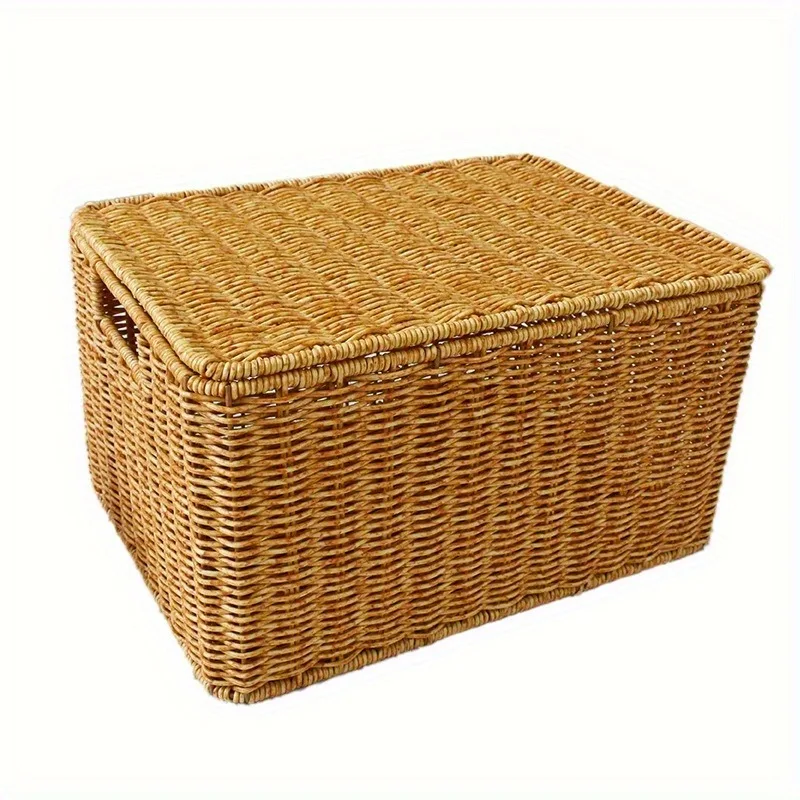
Selecting the ideal wicker laundry basket requires matching product features to your specific needs. Consider these key factors when evaluating options:
Construction Quality Indicators:
– Even, consistent weaving without gaps or loose ends
– Reinforced rim with secure binding
– Sturdy base that sits flat without rocking
– Handles woven into the structure rather than attached afterward
– Smooth finish without sharp protrusions
Material Selection Based on Location:
– Bathrooms: Synthetic wicker or water hyacinth for moisture resistance
– Bedrooms: Any natural wicker with emphasis on aesthetic appeal
– Laundry rooms: Sturdy rattan or reinforced seagrass for durability
– Children’s rooms: Synthetic wicker for easy cleaning
Price Considerations:
– Budget options ($20-40): Typically smaller with basic construction
– Mid-range options ($40-80): Better construction with added features like lids or liners
– Premium options ($80+): Exceptional craftsmanship, premium materials, distinctive designs
For comprehensive recommendations on quality options across price points, visit our guide to the best wicker baskets for laundry organization. This resource helps identify which features provide the most value for different household needs.
When examining product descriptions, look for details about material type, weaving technique, weight capacity, and included features like liners or dividers. Vague descriptions that omit these specifics often indicate lower-quality construction.
At Tidy Treasure, each basket undergoes thorough evaluation for consistent weaving patterns, structural stability, and material quality. This careful selection process ensures every piece meets our standards for both beauty and functionality.
Finding the Right Fit for Your Needs
Matching basket features to your specific household requirements ensures optimal functionality:
For Small Spaces:
– Look for corner-shaped designs that maximize awkward areas
– Consider stacking systems that utilize vertical space
– Select baskets with flat sides that sit flush against walls
– Evaluate multi-compartment options that provide sorting in minimal footprint
For Large Families:
– Calculate capacity needs based on 7-10 clothing items per family member per day
– Consider divided hampers for pre-sorting by multiple users
– Look for reinforced handles that withstand frequent movement of heavy loads
– Select materials prioritizing durability over delicate appearance
For Visual Impact:
– Choose distinctive weaving patterns that create visual interest
– Consider contrasting natural tones or painted wicker for accent pieces
– Look for unique shapes beyond standard rectangular or round options
– Select baskets with decorative touches like leather trim or textile accents
Households dealing with space constraints will appreciate our guide to conquering clutter with space-saving laundry solutions featuring compact yet effective wicker storage options.
When measuring your space, remember to account for:
– Door swing clearance if placing near entrances
– Lid opening space for baskets with top access
– Traffic patterns around the basket location
– Visual balance within the room
The perfect basket not only meets practical requirements but also enhances your specific environment, complementing existing décor while providing the organizational foundation for efficient laundry management.
Frequently Asked Questions About Wicker Laundry Baskets
Common Concerns Addressed
Can wicker baskets safely hold damp laundry?
Natural wicker can handle slightly damp items for short periods, but prolonged moisture exposure may cause mildew or weakening. For regularly damp items like bath towels, choose synthetic wicker or line natural baskets with washable cotton liners. Position baskets in well-ventilated areas and avoid placing wet swimwear or soaked garments directly in wicker containers.
How do I prevent wicker baskets from snagging delicate fabrics?
Quality wicker baskets should have smooth, finished surfaces without rough spots. For added protection with delicate fabrics, use cotton liners or fabric bags. Inspect your basket periodically for any protruding fibers and trim them carefully with small scissors. Rounded basket designs typically have fewer potential snag points than square-cornered options.
What’s the best way to prevent mold in wicker laundry baskets?
Maintain good airflow around the basket by elevating it slightly off the floor and keeping it away from damp walls. Empty baskets regularly rather than letting clothes sit for extended periods. For bathrooms and humid environments, consider using DIY laundry organization solutions like adding small silica gel packets at the bottom of the basket or treating natural wicker with a light application of tea tree oil, which has natural anti-fungal properties.
How much weight can a typical wicker laundry basket safely hold?
Most medium-sized wicker laundry baskets safely hold 20-30 pounds of clothing. Large baskets may accommodate up to 40 pounds, while smaller decorative pieces should be limited to 10-15 pounds. Exceed these limits regularly, and you’ll notice handle stress, bottom sagging, or weaving separation. When in doubt, use two baskets rather than overloading one.
Are wicker baskets difficult to clean if something spills inside?
For minor spills, blot immediately with an absorbent cloth, then allow to air dry completely. For more significant cleaning needs, use a soft brush with mild soap and water, focusing on affected areas. Apply cleaning solution sparingly to avoid saturating the material, and ensure thorough drying afterward. Synthetic wicker offers the easiest cleaning, as it can be rinsed directly without damage.
Where should I place wicker laundry baskets in a very small apartment?
In compact living spaces, consider dual-purpose placements like beside nightstands (where they can double as side tables), under wall-mounted bathroom sinks, inside closets with doors removed for access, or as decorative elements beside sofas. Vertical storage using tall, narrow hampers maximizes floor space efficiency. Corner-shaped designs utilize often-wasted space, while lidded versions provide additional surface area when closed.
The versatility of wicker baskets makes them adaptable to nearly any home environment, from spacious suburban houses to compact urban apartments. Their ability to function beautifully while enhancing your décor ensures they earn their keep as both organizational tools and design elements.

